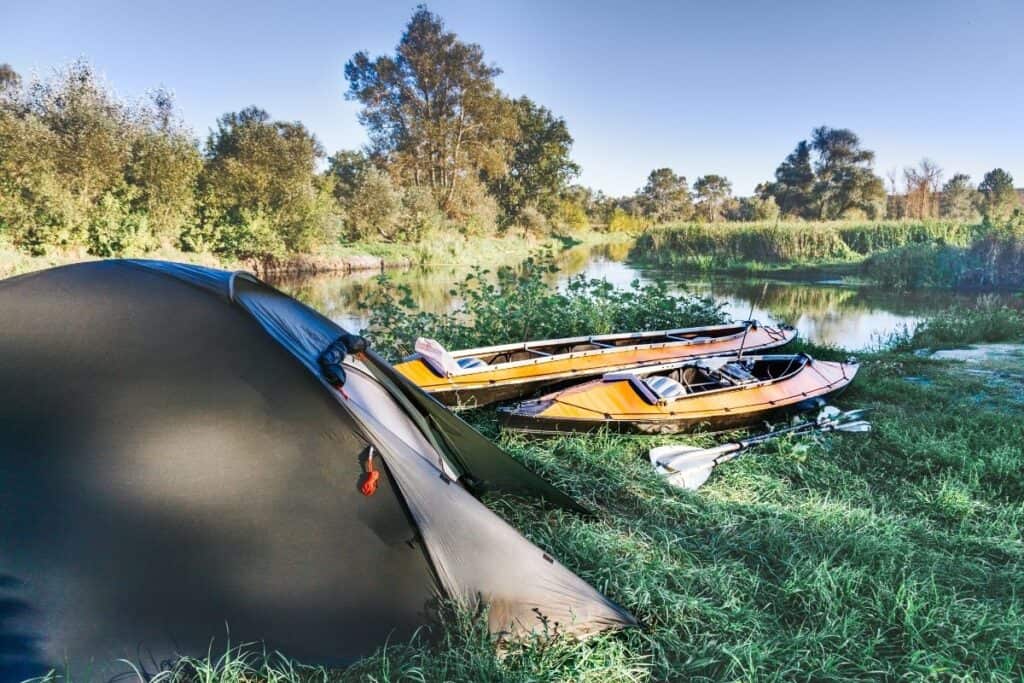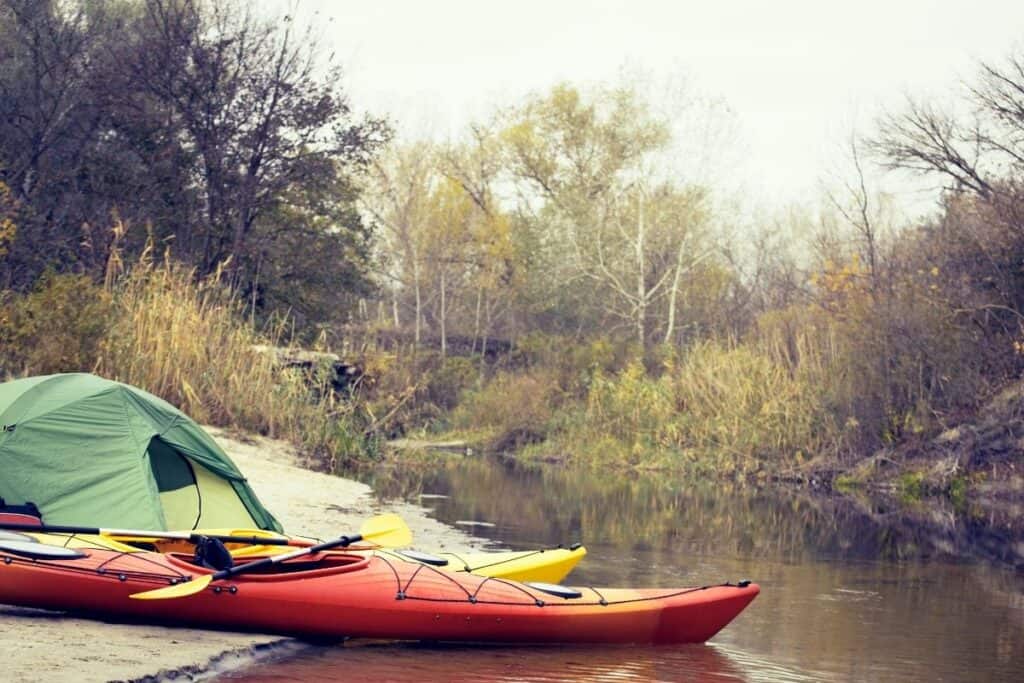
Have you ever heard the term “kayak camping” and wondered exactly what it meant?
Kayak camping is a blend of camping, backpacking, and kayaking, where kayaking serves as the primary mode of transportation to and from campsites and other destinations.
With that in mind, let’s take a deeper look at what kayak camping entails, and tips on what gear to bring to make the most of your own kayak camping trip!
Kayak Camping Explained
Simply put, kayak camping is a type of outdoor recreational activity (and, to some extent, a sport) where you travel from site to site over several days, using the kayak as your primary source of transportation between each location.
While you’re kayak camping, you’ll be sleeping in campsites on land. No matter how sleepy or tired you might get while paddling, it’s not a good idea to sleep in your kayak for reasons discussed below.
So, you’ll need to plan your route to ensure you swing by designated camping spots where you can either pitch a tent or hang a hammock until it’s time to get back on the water.
Kayak camping is widely beloved as a leisure sport now, but humans have used this form of travel for millennia. Heck, just look at all the river networks that connect all the corners of North America.
Indigenous tribes would use these water bodies as a primary method of travel (but, instead of a kayak, canoes were the main vessel). The routes were used to ferry each other between villages, ship goods across the landscape, and maintain communication with nearby tribes.
Now, most people flock to these sites to experience a bit of freedom and return to nature. If you’re one of those folks, you’ve come to the right place! Here are some tips on what to know and what to pack for your upcoming kayak camping trip.

What Do I Need for Kayak Camping?
Much of what you need for backpacking applies to kayak camping as well. This is because, as described earlier, all travel throughout your camping trip is based in the kayak.
In backpacking, you travel from place to place on foot (for the most part). You must store everything you need in a compact, portable vessel like a specialized backpacking pack in both cases.
You might also want to look into storage systems for your kayak as well, depending on the model. These ensure that you can comfortably keep all your essentials on your person, no matter where you are.
The best items to pack for your kayak camping trip, along with some useful tips, are discussed below.
What To Bring Kayak Camping
Since you’re essentially backpacking with a water-based method of travel, you’ll need to pack your bag nearly the same way you would if you were moving on foot between campsites.
Essential items you can carry in your pack are as follows.
Water-Resistant Sleeping Bag
Having a hydrophobic sleeping system is non-negotiable. Sleeping in wet clothes or a damp sleeping bag is a dangerous mistake, one that could quite literally cost you your life.
Water draws heat out of your body at a rate 25 times faster than air, making you exceptionally vulnerable to hypothermia. Normally, your body only loses about 2% of heat through conduction (the transfer of heat from your body to the environment or another object). If you’re drenched in wet gear, this can increase five-fold!
Sleeping bags with nylon outer layers, water-resistant finishes, and related hydrophobic treatments are best for keeping you warm and dry.
Sleeping Pad
The best way to preserve your body’s warmth is to create space between you and the ground!
This is because conduction also occurs when your body is in direct physical contact with another surface – in this case, the cold ground.
Just make sure it’s a lightweight sleeping pad, so you don’t weigh yourself or the kayak down.
Lightweight Tent or Hammock
Now that you understand why you should be sleeping on land – not in the water – you should pack a durable, lightweight tent.
There are lots of tents specially designed for backpacking. These are quick to pitch and break down and weigh around 3 lbs or less. (Some may get up to 5 lbs, but keep in mind that those 2 lbs can make a huge difference.)
Water Filter
One of the worst (and most common) mistakes that outdoor recreationists make is drinking contaminated water. You’re at an even greater risk of this issue since you’ll constantly be near the water.
It’s tempting to take a swig and convince yourself that “just a sip” won’t harm you, especially when the water looks clean. Still, that’s all it takes to make you sick.
Now, you can boil water from the river for a full minute to disinfect it. However, this option won’t be available while you’re on the water. Instead, you’ll need a filtration system to clean water on the go.
The best filters can get rid of microorganisms like Giardia and Cryptosporidium, saving you from a world of discomfort.
Camping Stove
You need to make sure you eat when you get to your campsite. Not all campgrounds allow open fires, so it’s best to keep your own cooking system in your pack.
The best camping stoves for kayak camping are compact and lightweight – you don’t need to bring a full grill to feed yourself and perhaps one other person.
Food and Water
Keeping yourself fed is essential to your energy and health throughout the trip. Don’t bring too many things, though. You might weigh your pack down.
Bring dehydrated, well-packaged meals and snacks (e.g., trail mix, dehydrated vegetables, granola bars, etc.) and keep the weight between 1.5-2.5 lbs of food per day, per person.
What to Store in Your Kayak
In order to make the most of the storage space you’ll have on your kayak, you need first to make the right choice of vessel.
The best types of kayaks that offer optimal storage space for multi-day trips include:
- Touring kayak
- Whitewater kayaks (e.g., playboats, river runners, creek boats)
- Inflatable whitewater kayaks
If you’ve got one of these, you’re good to go in bringing the following items on your trip. (Note that you can still make other kayak types work. However, it will be just a bit more challenging due to fewer storage options.)
Dry Bags
The best way to ensure all your gear stays dry, no matter how much water splashes into your kayak (or if you flip over), is to store it all in dry bags. These range from 5-55 liters, and you can store them either directly in the kayak or inside your pack.
Review the gear you’ll be bringing and decide how you want to store it to pick the appropriate capacity.
Kayak Repair Kit
Accidents happen, and your kayak is not exempt. If you happen to float into rocky terrain and get a nick in the boat, having an emergency kit on hand can save the trip, and potentially, your life.
The kit should primarily include adhesives and tools to apply and set that adhesive. However, you can add items like bungee cords, multitools, and wire for more complicated fixes.
First Aid Kit
Of course, you need to be prepared to “repair” yourself, too. You can choose to store your first aid kit in either your pack or the kayak itself. Either way, make sure it’s water-resistant!
Since the hypothermia risk is higher thanks to all the time you’ll be spending on the water, include an emergency blanket in the kit to keep you warm as a last resort.
Flotation Devices
Any time you’re in a boat, you should be wearing the appropriate protective equipment.
Make sure each person on your trip has their own personal flotation device to prevent fatal accidents.
Rescue Signal or Flare
No matter how much attention you put into preparation, there could be a time when your repair kit or first aid kit can’t get you out of trouble. In that case, you need to have a way to call for help.
Rescue devices or flares are the best way to get a rescue crew’s attention, even if you’re miles into a remote location.
Kayak Camping Tips
Before you head out on the water, there are a few things you’ll need to know to have a successful trip.
Check out the tips below to ensure a fun, safe adventure for you and your companions.
Can You Sleep in a Kayak?
You may have seen canoe campers doing this, but this doesn’t mean that you can do the same in your kayak.
Consider the differences between the two:
- Canoes are much different vessels that have more open space. Its design is much more accommodating for an overnight sleeper.
- Kayaks are intended to be used in an upright position, as evidenced by the small cockpit. Sleeping in your kayak increases your chances of getting injured or dying in an accident due to capsizing or a similar mishap. There’s also no reliable way to anchor an occupied kayak overnight, so you risk drifting off downriver while you snooze.
“Parking” Your Kayak Overnight
It’s unlikely that you’ll be on the water for your whole trip. Since you can’t sleep in your kayak, your best bet is to keep it simple and choose a campsite on the shore.
To keep your kayak secure in the night, pull it up onto shore, so it rests on the dirt or sand. You can also use grapnel anchors around 3 lbs or more or bruce claw anchors if there’s no ideal “parking” spot.
Keep in mind that while these anchors are reliable in extreme weather conditions, waters with rocky bottoms would render them useless.
Advice on Packing Your Kayak
Your kayak will need to be optimally packed to prevent it from capsizing.
Heed the following tips to make sure you organize your vessel correctly:
- Store lightweight items as far into the bow (front) and stern (back) as you can.
- Place the things you frequently need (such as a bag with water, map, compass, etc.) near the hatches.
- Water bladders and other heavy items should be stored low and in the center of the kayak. Water is especially dangerous to pack incorrectly since it sloshes around, which can potentially throw your kayak’s balance off. Keep it to ½-1 gal and no more.
- Keep the heaviest items and your emergency supplies nearest the cockpit.
Summary
Kayak camping is one of the world’s oldest and most widely practiced sports. Many outdoor enthusiasts fall for this sport quickly since it’s a blend of all the best parts of several recreational activities.
With this guide, you finally have an answer to your burning question, “What is kayak camping?” and along with it, the crucial tools to get ready for your next safe, fun trip on the water.
Related Articles
If you found this article helpful, then make sure to take a look at some of these related posts as well!
